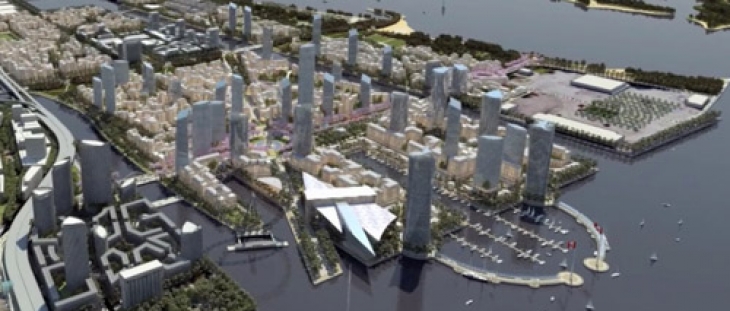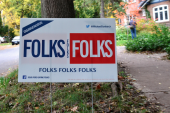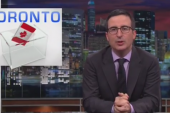
 On Tuesday, City Hall released renderings of their vision for the Port Lands waterfront development at the mouth of the Don River. The Fords had been dropping hints, but the sudden unveiling seemed to come as a surprise to most of city council. While Waterfront Toronto protested that it could still complete the development plan it had been charged with creating, councillors on the executive committee voted Tuesday not only to approve Ford’s plan and officially scuttle the group’s decade of work, but also to evict control from them. All this amid rumours that the Fords communicated with Australian lobbyists without council’s knowledge while secretly plotting to privatize all development of the area. The politics will only get messier as we approach the full council vote September 21st. But in the foofaraw one important question is being overlooked: is the plan actually any good? The first word comes from the project’s chief architect, Eric Kuhne of UK firm Eric Kuhne & Associates, who was in Toronto Tuesday to present the vision. “What we have tried to do is collect them all together and tried to arrange a banquet of new possibilities. It’s not a plan. It’s just a collection of powerful ideas that came to us and what we tried to do is arrange the banquet table so that there’s a place for everybody.” For something cobbled together in an attempt to please everyone, it manages to retain some edge. It contains, among other things, a mega-mall, an elevated monorail that leaves from Union Station and loops around the Port Lands before connecting to a light rail terminal in Ashbridges Bay, and–infamously–what would be the world’s largest Ferris wheel. And while that may sound like a little of everything thrown haphazardly into a post-industrial wasteland and branded a tourist attraction, it seems a great deal of thought may have actually gone into it. Some of the most striking features of the plan are not tourist attractions but major landscaping. The Don River will be partially diverted (or rather, undiverted) due south, irrigating a green beltway of parkland that bisects the Port Lands after the fashion of New York’s Central Park. The “Diagonal Parade,” a boulevard running from a new obelisk towards the CN Tower, will provide a sightline not unlike the Champs Elyses connecting the Arc de Triomphe and Place de la Concorde in Paris. On the west shore, new marinas offering spectacular views of the skyline will likely entice more nautical tourism. Last but not least, there’s the “Emerald Necklace,” a perfectly elliptical path that will weave between buildings and over swing bridges to embrace the whole development. You may need a bird’s-eye view to fully appreciate it, but luckily the CN Tower is just a monorail ride away. Speaking of the more ludicrous-sounding flourishes–the monorail, the Ferris wheel–there may be some sense even to these. The Ferris wheel, at least in Doug Ford’s projections, is merely to generate cash; he could cite the Millennium Eye in London, which reportedly made over 50 million in profit in 2009, to back up his claim (granted–it’s in London, not Toronto). As for the monorail, it’s hard to even contemplate it without Lyle Lanley’s catchy sales pitch from the Simpsons’ running through your head. Monorails undeniably have a reputation for breaking down and going over-budget. But if you look hard enough and you’ll find examples of monorails that work, notably the eleven currently operating in Disney World Orlando, shuttling 50 million passengers a year.
On Tuesday, City Hall released renderings of their vision for the Port Lands waterfront development at the mouth of the Don River. The Fords had been dropping hints, but the sudden unveiling seemed to come as a surprise to most of city council. While Waterfront Toronto protested that it could still complete the development plan it had been charged with creating, councillors on the executive committee voted Tuesday not only to approve Ford’s plan and officially scuttle the group’s decade of work, but also to evict control from them. All this amid rumours that the Fords communicated with Australian lobbyists without council’s knowledge while secretly plotting to privatize all development of the area. The politics will only get messier as we approach the full council vote September 21st. But in the foofaraw one important question is being overlooked: is the plan actually any good? The first word comes from the project’s chief architect, Eric Kuhne of UK firm Eric Kuhne & Associates, who was in Toronto Tuesday to present the vision. “What we have tried to do is collect them all together and tried to arrange a banquet of new possibilities. It’s not a plan. It’s just a collection of powerful ideas that came to us and what we tried to do is arrange the banquet table so that there’s a place for everybody.” For something cobbled together in an attempt to please everyone, it manages to retain some edge. It contains, among other things, a mega-mall, an elevated monorail that leaves from Union Station and loops around the Port Lands before connecting to a light rail terminal in Ashbridges Bay, and–infamously–what would be the world’s largest Ferris wheel. And while that may sound like a little of everything thrown haphazardly into a post-industrial wasteland and branded a tourist attraction, it seems a great deal of thought may have actually gone into it. Some of the most striking features of the plan are not tourist attractions but major landscaping. The Don River will be partially diverted (or rather, undiverted) due south, irrigating a green beltway of parkland that bisects the Port Lands after the fashion of New York’s Central Park. The “Diagonal Parade,” a boulevard running from a new obelisk towards the CN Tower, will provide a sightline not unlike the Champs Elyses connecting the Arc de Triomphe and Place de la Concorde in Paris. On the west shore, new marinas offering spectacular views of the skyline will likely entice more nautical tourism. Last but not least, there’s the “Emerald Necklace,” a perfectly elliptical path that will weave between buildings and over swing bridges to embrace the whole development. You may need a bird’s-eye view to fully appreciate it, but luckily the CN Tower is just a monorail ride away. Speaking of the more ludicrous-sounding flourishes–the monorail, the Ferris wheel–there may be some sense even to these. The Ferris wheel, at least in Doug Ford’s projections, is merely to generate cash; he could cite the Millennium Eye in London, which reportedly made over 50 million in profit in 2009, to back up his claim (granted–it’s in London, not Toronto). As for the monorail, it’s hard to even contemplate it without Lyle Lanley’s catchy sales pitch from the Simpsons’ running through your head. Monorails undeniably have a reputation for breaking down and going over-budget. But if you look hard enough and you’ll find examples of monorails that work, notably the eleven currently operating in Disney World Orlando, shuttling 50 million passengers a year.  Any new commerce and tourist hub, but especially one on an isolated area of waterfront mostly cut off from downtown by channels of water, will require high-speed public transit. The proposed monorail route, from Ontario Place to the Air Canada Centre, to Union Station, and on to the Port Lands’ future mega-mall, not only creates a much-needed transit corridor for the extant waterfront, but also moves vast numbers of people over these channels of water. Any plan for the area that’s going to succeed will have to address the problem of how to cross these expanses, and a monorail is as reasonable a solution as any. The realistic alternatives, like a new bus line fighting the Gardiner traffic between Union Station and the Don Roadway, are really too depressing even to contemplate. Kuhne, the architect, is one of the top designers of waterfronts worldwide, having completed projects on five continents, including the largest shopping mall in Europe, and the in-progress City of Silk in Kuwait. The Toronto Port Lands scheme, in particular, draws connections to his earlier work for a park in Indiana, a waterfront in Belfast, and a wharf in Sydney–all successful rehabilitations that involved challenges similar to those facing Toronto’s waterfront today. The Ferris wheel may be Ford’s, but presumably the topography and infrastructure are Kuhne’s. The last word ultimately belongs to city council. The Fords haven’t done much to endear themselves to their colleagues, which will make selling the plan difficult regardless of its merits. While it’s doubtful that the plan will proceed exactly as it appears now, even if council approves it in a couple weeks, one thing is certain: any changes to this plan will be for the worse. Design by committee almost always leads to a watering-down, a removal of bold or controversial gestures. Studying the renderings released this week, it’s easy to get caught up in the details, but what makes any waterfront revitalization succeed or fail goes on in the bigger picture. Can the Port Lands be developed cheaply enough that local revenue will sustain them? Will there be enough attractions to draw people from across the city and beyond? Will it be pleasant to visit? And most of all, how easy will it be to get to? To get this right, we can’t go half-way. While the more outlandish touches feel like something that must have come to Ford in a fever dream, maybe that’s not such a bad thing. Christopher Hume at the Toronto Star pejoratively compared Ford’s plan to Disneyland, but perhaps a little taste of the World of Tomorrow is what the project needs. The alternative may be more of the same as we already have, which is exciting to exactly no one. Toronto has suffered from the neutralization of its bolder schemes in the past, and if the Port Lands are to be different from, say, Vaughan or Scarborough, they’ll have to be developed according to a clear and uncompromising vision. Is that vision Doug Ford’s? And is he the one to develop it? Maybe the question isn’t whether Brother Ford is up to the task, but rather, who else is? Council may agree on something less preposterous, but it will never agree on anything more interesting. __ David Dick-Agnew is a blogger, artist, and sometime curator who has worked for Azure and Designlines magazines.
Any new commerce and tourist hub, but especially one on an isolated area of waterfront mostly cut off from downtown by channels of water, will require high-speed public transit. The proposed monorail route, from Ontario Place to the Air Canada Centre, to Union Station, and on to the Port Lands’ future mega-mall, not only creates a much-needed transit corridor for the extant waterfront, but also moves vast numbers of people over these channels of water. Any plan for the area that’s going to succeed will have to address the problem of how to cross these expanses, and a monorail is as reasonable a solution as any. The realistic alternatives, like a new bus line fighting the Gardiner traffic between Union Station and the Don Roadway, are really too depressing even to contemplate. Kuhne, the architect, is one of the top designers of waterfronts worldwide, having completed projects on five continents, including the largest shopping mall in Europe, and the in-progress City of Silk in Kuwait. The Toronto Port Lands scheme, in particular, draws connections to his earlier work for a park in Indiana, a waterfront in Belfast, and a wharf in Sydney–all successful rehabilitations that involved challenges similar to those facing Toronto’s waterfront today. The Ferris wheel may be Ford’s, but presumably the topography and infrastructure are Kuhne’s. The last word ultimately belongs to city council. The Fords haven’t done much to endear themselves to their colleagues, which will make selling the plan difficult regardless of its merits. While it’s doubtful that the plan will proceed exactly as it appears now, even if council approves it in a couple weeks, one thing is certain: any changes to this plan will be for the worse. Design by committee almost always leads to a watering-down, a removal of bold or controversial gestures. Studying the renderings released this week, it’s easy to get caught up in the details, but what makes any waterfront revitalization succeed or fail goes on in the bigger picture. Can the Port Lands be developed cheaply enough that local revenue will sustain them? Will there be enough attractions to draw people from across the city and beyond? Will it be pleasant to visit? And most of all, how easy will it be to get to? To get this right, we can’t go half-way. While the more outlandish touches feel like something that must have come to Ford in a fever dream, maybe that’s not such a bad thing. Christopher Hume at the Toronto Star pejoratively compared Ford’s plan to Disneyland, but perhaps a little taste of the World of Tomorrow is what the project needs. The alternative may be more of the same as we already have, which is exciting to exactly no one. Toronto has suffered from the neutralization of its bolder schemes in the past, and if the Port Lands are to be different from, say, Vaughan or Scarborough, they’ll have to be developed according to a clear and uncompromising vision. Is that vision Doug Ford’s? And is he the one to develop it? Maybe the question isn’t whether Brother Ford is up to the task, but rather, who else is? Council may agree on something less preposterous, but it will never agree on anything more interesting. __ David Dick-Agnew is a blogger, artist, and sometime curator who has worked for Azure and Designlines magazines.














